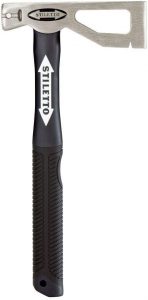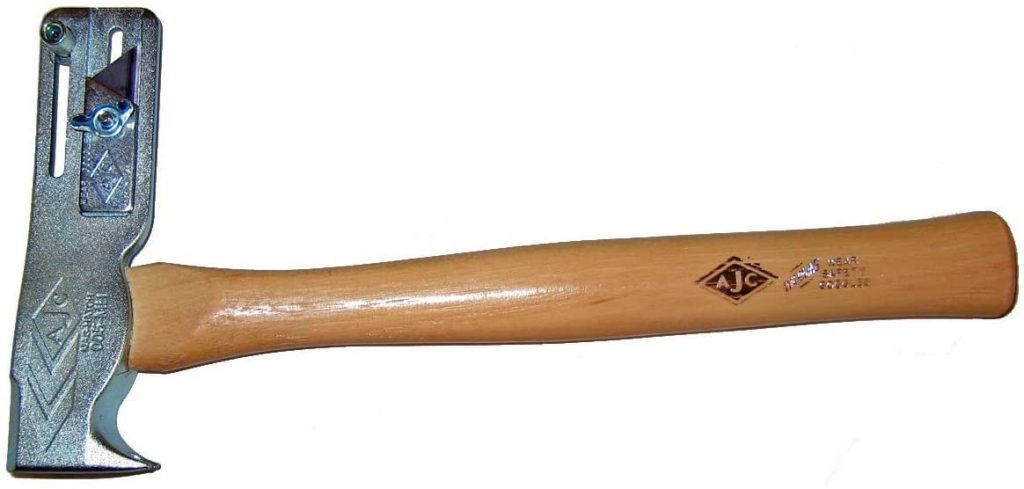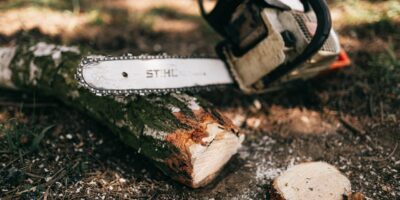Roofing is a serious task, so you need the best tools at your disposal. If you’re performing a DIY fix on your roof, you must invest in the best hammer for roofing that can take the beating of intense use. The last thing you want is a broken hammer in the middle of a busy day. Aside from roofing, you can also use the same hammer for other projects like woodworking and so on.
The following are three of my favorite hammers that I always keep handy in my workshop and garage.
| ROOF HAMMER | BRAND | EXPERT RATING | CHECK PRICE |
|---|---|---|---|
| Our Top Pick! Stiletto 10-Ounce Lathe Axe Hammer | Check Price | ||
 | Picard Roofing Hammer | Check Price | |
| AJC 17-Ounce Roofing Hatchet Hammer | Check Price |
What is a roofing hammer?
A roofing hammer is a specialized tool used for roof purposes. It’s made to perform tasks that other hammers can’t do. Aside from driving and pulling nails, a roofing hammer can also position shingles. Also, most roofing hammers are lightweight to prevent serious injuries should the tool fall to the ground.
One of the most notable features of roofing hammers is its hatchet tip. Its head is usually divided into a hammer tip and a hatchet tip on each side. The hatchet tip allows roofers to remove or position shingles while the hammer tip is useful when placing fasteners.
In short, a roofing hammer packs multiple tools in one. This makes roofing jobs much easier and safer.
Take note that roofing jobs need special hammers that will not damage the head of the nails. Remember that overdriven nails will create a space where water can seep under the roof. This will lead to water damage and rot, which could be expensive to repair in the future.
Roofing hammer vs. nail gun
Thanks to the advancements in power tools, you can now switch from the classic hammer into a nail gun. A nail gun takes away the manual pounding and risks associated with traditional hammers.
Aside from that, a nail gun is convenient since you no longer have to hold the nail and keep it in place. It uses pressurized air to shoot the nail into the surface at high speed. It’s like a staple gun, but much larger and heavier.
The only thing I worry about nail guns is safety. If you lost your balance and pressed the trigger accidentally, your roofing project could lead to freak accidents.
Aside from that, nail guns are more expensive than hammers. Despite that, nail guns prove useful for other projects like woodworking.
Types of roofing hammers
Roofing hammers are available in different types, with each one playing a specific role. The following are the widely used types among roofers:
✔️Roofing hatchet. One of the most common roofing hammers is a roofing hatchet. This looks like a small axe used in shingle removal and installation. It also comes with a flat surface that can be used in driving nails. Aside from that, roofing hatchets also function as a knife and nail puller.
✔️Double-claw hammer. A double-claw hammer is used for general roofing purposes. It can be used to pry shingles and pull nails out. A hammer with a straight claw can be used for light demolition if you need to replace a portion of your roof.
✔️Roofing pick hammer. This one has a sharpened pick that doubles as a claw. Roofing pick hammers are also used for pulling and driving nails. You can also utilize this to punch holes on the roof as necessary.
Slate hammer. Another roofing hammer is the slate hammer. It comes with a sharp and pointed pick that you can use to punch holes, pull nails, or make beveled shafts.
Safety tips when using a roofing hammer
DIY roofing jobs can turn dangerous if you don’t observe safety measures. Hammers are risky if it falls from the roof and into someone below. To ensure that it will not happen, you must do the following:
✔️Wear a face shield. You should always wear goggles or face shield to prevent any facial injuries should the hammer or the material you’re pounding recoils.
✔️Get a hammer with a solid grip. A roofing project can be disastrous if your hammer has a slippery handle. The hammer must have a solid and ergonomic handle that will not slip out of your hands even if you get sweaty.
✔️Always make a square blow. Square blows land flatly into the surface. This prevents chipping and the risk of the debris flying into your direction.
✔️Always check the hammer head. At some point, the head of the hammer may become loose. Make sure that you check this part before proceeding to your roofing task.
✔️Keep your footing. One of the struggles of roofing jobs is keeping a solid footing. Before you hammer things, make sure that you have a firm position on the roof.
How to choose the best hammer for roofing
When shopping for a roofing hammer, you must consider the following points:
Choose the right type
You must select a hammer type based on the tasks you have at hand. If you need to remove shingles or pull nails, a roofing hatchet or double-claw hammer might be what you need. No matter what type you’re getting, you should always invest in a high-quality hammer that will last for years.
Look for a durable handle
Aside from the head quality, make sure that the hammer has an ergonomic handle. This will prevent the hammer from flying away during a forceful strike. Also, it will reduce the strain while you’re working on your roof.
Wood handles are common among hammers. If you’re opting for this handle material, make sure that it’s solid and not prone to splintering.
Get one with a nail starter
If you’re getting a dual claw hammer, I recommend one with a nail starter. This will save you from the need to hold the nail with the other hand. It’s an added safety feature that will spare your thumb. Aside from that, it will help to steady yourself on the roof.
Consider an anti-vibration style
Lastly, look for a roofing hammer with an anti-vibration feature. This will reduce the impact of hammering on your hand and wrist. Such a feature is beneficial for those suffering from hand pain and arthritis.
Best Hammer For Roofing – Top 3 Picks!
MY #1 CHOICE
MY TOP PICK: Stiletto 10-Ounce Lathe Axe Hammer

Product Name: Stiletto 10-Ounce Lathe Axe Hammer
Product Description: If you’re looking for a reliable hatcher hammer, you’ll never go wrong with the Stiletto Lathe Axe Hammer. It has a fiberglass handle that remains solid even after years of use. Aside from that, it has a strong bond between the handle and head to reduce accidents. The head of this hammer weighs 10 ounces with a 13-ounce handle. Its head is made of solid milled titanium, so it doesn’t chip easily. Overall, this is a very comfortable hammer to use. It also leverages the weight of the handle for stable and stronger blows.
Offer price: $$$
Availability: InStock
-
Durability
-
Value for Money
-
Ease of Use
-
Efficiency
Overall
Summary
Moreover, this hammer has an integrated rubber over the molding to reduce hand fatigue and to boost the grip. There’s also a three-position magnetic nail starter, so you no longer have to hold the nail all the time.
The Stiletto Lathe Axe Hammer is designed to have 10 times less recoil shock for your safety. It’s also lightweight and about 45% lighter than other lathe axe counterparts.
As a roofer’s hatchet, this hammer from Stiletto is made to last for years. Although it comes at a higher price, every cent is paired with topnotch quality.
Pros
Solid titanium head
3-position magnetic nail starter
Less recoil shock
Cons
So far so good
RUNNERS-UP
Picard Roofing Hammer

Another roofer’s hammer that I recommend is this one from Picard. This is designed to endure the toughest roofing and carpentry tasks. It’s made for home, shop, or field use, whatever the material is.
The head of hits hammer is made of a single-piece metal wherein the neck and forged together. This takes out the risk of loose hammer heads. Aside from that, this hammer has a disc-stacked leather handle as well as a full-length head plate.
Moreover, this hammer comes with a magnetic nail slot on its fully polished head. Overall, it weighs 960 grams that’s well balanced all over the hammer. Its head accounts for most of the weight of about 600 grams. Overall, this hammer is 13.7 inches long, which is very comfortable to hold.
The Picard roofing hammer is made for real-world conditions, something that the brand is known for when it comes to their tools. It also has a square head for precise blows every single time. The hammer also sits well on the hands and easy to get used to.
Regardless if you’re a hobbyist or a roofer by profession, this hammer is a must-have!
AJC 17-Ounce Roofing Hatchet Hammer

If you’re looking for a cheaper roofing hatchet, you should get this one from AJC. Aside from being a hammer, this tool also sports a nail claw, sliding gauge, and a built-in blade. You can now do more with this hammer than other options you can find in the market.
This is a lightweight hammer that’s available in 7-ounce sizes. It’s the perfect tool for cap-nailing, where you can drive cap nails faster than other hammers. This is great in felting, too, which is why many roofers swear by it.
Aside from that, this hammer comes with a magnetic head with a nail starter. It cuts the strain and hammering time so you can finish more tasks. Since it’s lightweight, you will experience less strain and fatigue when fixing a large portion of your roof.
The only thing I noticed is that the cutting blade on this one is like a typical blade. It may not hold up on tough cutting jobs, but you can always replace it with a more durable one as you like. For its price, I don’t have major complaints.
Frequently Asked Questions
Q: What is a shingling hatchet?
A: A shingling hatchet is used on extracting nails and removing roof shingles. It comes with a notch on the blade, which is reminiscent of an actual hatchet. The other tip of shingling hatchet has a hammer-like head that lets you drive nails and pound on shingles to put it in place.
Q: How many nails do I need to put in a 3-tab shingle?
A: For a 3-tab shingle, you need four nails for every full shingle. Also, the nails must be 11 or 12-gauge and corrosion-resistant. Meanwhile, the heads should be 9.5 mm in size and 1-inch long. This will ensure that the nails will pass through the shingle properly.
Q: Can you hammer through a shingle?
A: Yes, you can hammer and use nails on a shingle. However, roofers use a special technique to prevent the shingle from shattering. Also, professional roofers use special nails and screws so it will not compromise the quality of your roofing system.
Q: What is high nailing in shingle roofs?
A: High nailing is a term that refers to the manner of placing fasteners like nails on top of the shingle’s adhesive strip. When a roofer does this, the shingle will not seal properly, and it will have poor wind-resistance. Remember that when you’re doing DIY roofing, you should keep fasteners on the green strip area.
Q: What kind of nails do you use for shingles?
A: When it comes to shingle roofs, it’s advisable to use galvanized roofing nails. These are specialized nails that are not prone to corrosion. It’s also zinc-coated and suitable for asphalt shingles. Make sure that the nails are at least 11-gauge for it to last long.
Final words
With the best hammer for roofing, you can fix your roof with ease. Unlike other hammers, those made for roofing have special features that make every task easier, faster, and safer. If you’re an aspiring roofer, the three hammers I reviewed here are a good start for your toolkit.


